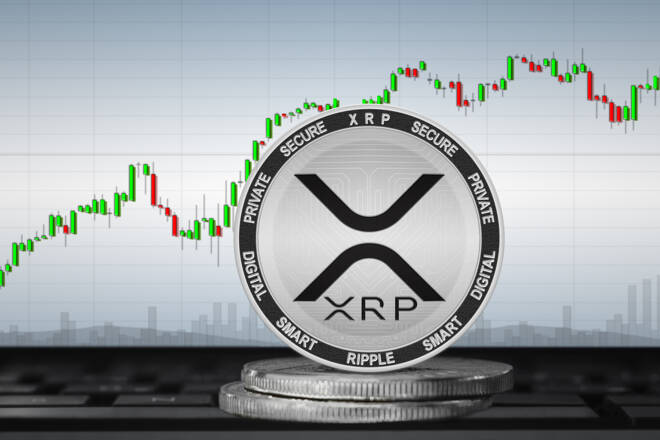Advertisement
Advertisement
XRP News Today: Is the SEC Waiting on Atkins to Vote on Ripple Appeal? BTC Eyes $100K
By:
Key Points:
- SEC’s appeal delay raises uncertainty as XRP investors await clarity on Ripple’s legal battle and ETF market prospects.
- Paul Atkins’ confirmation could be a turning point in Ripple’s SEC case—will it finally bring regulatory clarity to XRP?
- US states push for a Strategic Bitcoin Reserve, with North Carolina proposing a 10% BTC allocation—could this drive Bitcoin to new highs?
SEC vs. Ripple: Is the SEC Waiting for Atkins’ Confirmation?
The SEC vs. Ripple case remains a focal point after the SEC filed its appeal-related opening brief on January 15. Hopes for a swift resolution to the SEC’s appeal against the Programmatic Sales of XRP ruling have faded.
Despite SEC Chair Gary Gensler’s departure and President Trump’s appointment of Mark Ueyda as acting Chair, the agency has remained silent. Commissioner Hester Peirce now leads a newly formed Crypto Task Force, yet no official updates have surfaced regarding Ripple.
One possibility is that the SEC’s Commissioners await Paul Atkins’ confirmation before deciding. President Trump nominated the former SEC Commissioner Paul Atkins as Chair on December 4. However, details of Atkins’ confirmation remain scarce.
Fox Business journalist Elenor Terrett shed light on the delay, stating:
“Atkins will have his hearing in front of the @BankingGOP, a date for which has not yet been set, and then if his nomination advances out of committee (which it’s expected to), he will then be voted on by the full Senate. For reference, Gensler was not confirmed by the Senate until April of 2021 after being nominated by Biden in January of that year. Jay Clayton was not confirmed until May 2017 after Trump nominated him in January 2017.”
If acting Chair Ueda and Commissioner Peirce are waiting for Atkins’ confirmation before determining the SEC’s stance on the Ripple appeal, it could be a long wait. Terret stated that there are nine Senate and cabinet members, along with dozens of administration members, still awaiting confirmation. Terrett added that Senate and cabinet members typically are the first to get confirmed.
Uncertainty about whether the SEC will continue or withdraw its appeal leaves XRP in limbo in the near term.
XRP Price Trends: Appeal Uncertainty Keeps XRP in Check
On Monday, February 10, XRP gained 1.24%, reversing Sunday’s 1.04% loss to close at $2.4243. XRP mirrored the broader market, which advanced by 1.16%, lifting the total crypto market cap to $3.14 trillion.
A potential delay in the SEC’s appeal decision could hinder progress toward launching a US XRP-spot ETF market. XRP may face weaker demand if the SEC delays approving or rejecting recently submitted XRP-spot ETF applications while approving other crypto-spot ETFs.
Key Price Scenarios:
- Bullish Case: If the SEC withdraws its appeal, XRP could rally past its all-time high of $3.5505.
- ETF Catalyst: Approval of an XRP-spot ETF may drive XRP toward $5 on increased institutional demand.
- Bearish Case: If the SEC proceeds with the appeal, XRP could slide below $1.50.
Click here to find out why analysts believe XRP could skyrocket—or crash—based on the SEC’s decision.
BTC Advances as Strategic Bitcoin Reserve Progress Gains Traction
Beyond the Ripple case, developments related to the Strategic Bitcoin Reserve (SBR) have drawn interest. On February 10, House Speaker Dustin Hall introduced HB 92, a bill proposing North Carolina adopt BTC as a strategic reserve asset. If passed, North Carolina could allocate 10% of State funds into BTC ETFs.
The bill follows the House for Utah’s recent passing of an SBR bill. Other US states exploring SBR legislation include Alabama, Arizona, Florida, Kentucky, Massachusetts, Montana, New Hampshire, North Dakota, Ohio, Oklahoma, Pennsylvania, South Dakota, Texas, and Wyoming.
A broader push for SBR legislation in Republican Party-led states could pressure the US administration to accelerate progress toward a US SBR. In late 2024, Senator Cynthia Lummis introduced the Bitcoin Act. The bill proposes that the US government acquire one million BTC over five years, with a mandatory holding period of 20 years.
A US SBR would materially tilt the supply-demand balance in BTC’s favor, driving BTC to unprecedented levels.
In January, Bitwise Chief Investment Officer Matt Hougan projected BTC could surpass $200k by December 2025, citing ETFs, public companies, and government demand outstripping supply.
Bitcoin Price Outlook
On Monday, February 10, BTC gained 0.97%, reversing Sunday’s 0.13% loss, closing at $97,469. Despite progress toward a US SBR, BTC saw modest gains amid escalating US-China trade tensions and shifting sentiment toward the Fed rate path.
Key Factors to Watch
- US Tariff Developments
- SBR Legislative Updates
- US CPI Report and Fed Chair Powell Testimony
- US BTC-Spot ETF Market Flow Trends.
Possible Scenarios:
- Bearish Scenario: Wider US tariffs, higher US inflation, a hawkish Fed Chair, and stalled US SBR discussions could pull BTC toward $90,000.
- Bullish Scenario: Easing US-China trade tensions, softer inflation, a dovish Fed, and progress on a US SBR may drive BTC toward its all-time high of $109,312.
Market Outlook: Regulatory Developments in Focus
As investors assess recent market trends, two key regulatory factors will influence crypto sentiment in the coming months:
- SEC’s appeal strategy in the Ripple case.
- Progress of US Strategic Bitcoin Reserve legislation.
Both developments may significantly impact institutional adoption and market momentum.
Stay updated with our expert analysis of these developments and their implications for crypto markets. Explore the full analysis here.
About the Author
Bob Masonauthor
With over 28 years of experience in the financial industry, Bob has worked with various global rating agencies and multinational banks. Currently he is covering currencies, commodities, alternative asset classes and global equities, focusing mostly on European and Asian markets.
Did you find this article useful?
Latest news and analysis
Advertisement
